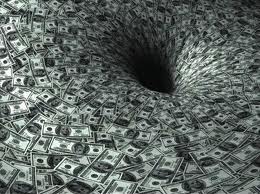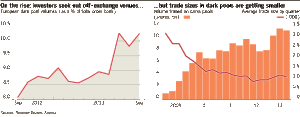“Unless there are some changes, there’s going to be a massive crash, a flash crash times ten.” Ron Morgan and Brian Levine, Goldman Sachs
As recently as 2005, dark pools made up 3% to 5% of trading activity. Today, it’s 12%.
Dark pools are like fraternal clubs, but without the secret handshake. No one talks about them, so they’re a mystery to the world at large. Many were unfamiliar with dark pools until this past week, when The Wall Street Journal announced that Goldman Sachs is planning to close its Sigma X dark pool, which is one of the industry’s largest and darkest pools. (Goldman has not confirmed that action.)
So what is a dark pool? It’s a stock exchange where trading takes place in the “dark,” which means the size and price of orders are not revealed to other participants.
To some extent, dark pools are a reaction to high-frequency trading (HFT), which we discussed last week and in other previous posts. When trades take place in the dark, algorithmic traders can’t take advantage of them.
Theoretically, if dark trades, which are typically high volume trades, took place in the light of day, high-frequency traders would amplify the impact of such trades and potentially cause another flash crash. Or worse.
But on Wall Street, of course, nothing is ever that simple. There’s more to dark pools than that. Consider some of the questions that dark pools raise:
In an age where everyone talks about “transparency,” why do so many trades need to be made anonymously, in the dark? What are these traders trying to hide?
Wall Street says HFT is a good thing, creating market efficiency and liquidity, so why do we need dark pools to protect markets from HFT?
Dark pools have been blamed for severe and unexpected swings in stock prices. How can dark pools create efficiency if they’re creating volatility?
The Origin of Dark Pools
Like HFT, dark pools are a by-product of the move to electronic trading. They first started forming in the 1980s, when some institutional investors were seeking a place to trade without nosy public exchanges or brokers knowing what they were doing, so they could buy or sell large volumes of stocks with affecting the market, while obtaining better execution prices.
Dark pools grew deeper and darker beginning in 2007, when the Securities and Exchange Commission passed Regulation National Market System, aka Reg NMS, which was designed to stimulate the growth of electronic trading.
Among other things, Reg NMS increased competition by enabling investors to skip exchanges if they could find a better price more quickly elsewhere. It also eliminated the rules that protected manual quotations by exchanges.
Broker-dealers reacted by creating dark pools, and some large investors started using them, in part to save on trading costs while obtaining pricing improvements.
“The thing is, though,” as Business Insider put it, “you don’t know who else is in the dark pool with you and you don’t know if anyone wants what you’re selling at all.”
And while dark pools may improve pricing for the investors who use them, they may also hinder price discovery, according to Haoxiang Zhu of the MIT Sloan School of Management. He considers both sides of the argument in his paper, “Do Dark Pools Harm Price Discovery?”
“Informed traders tend to trade in the same direction, crowd on the heavy side of the market, and face a higher execution risk in the dark pool, relative to uninformed traders,” he writes. “Consequently, exchanges are more attractive to informed traders, and dark pools are more attractive to uninformed traders. Under certain conditions, adding a dark pool alongside an exchange concentrates price-relevant information into the exchange and improves price discovery. Improved price discovery coincides with reduced exchange liquidity.”
However, in a 2009 survey, the CFA Institute found that 71% of respondents believe that the operations of dark pools are “somewhat” or “very” problematic for price discovery. The Securities and Exchange Commission also noted in 2010 that it considers “the effect of undisplayed liquidity on public price discovery” to be an important regulatory question.
In other words, dark pools provide better pricing for the big institutional investors who use them and worse pricing for the rest of us.
Closing Sigma X
So, given the advantages, why would Goldman Sachs consider closing one of the world’s largest dark pools?
For one thing, dark pools have become increasingly more competitive and, as a result, less profitable. In fact, equity trading in general has become less profitable and Goldman reportedly is in talks to sell its equity trading unit.
The other reason, though, is that dark pools – like HFT – are under close scrutiny from regulators. The SEC is considering changes that would limit the trades in dark pools and perhaps even take the “dark” out of dark pools.
Public stock exchanges are pressuring regulators for change, arguing that investors are being hurt by pricing that may not truly reflect the market. After all, aren’t markets supposed to price stocks efficiently?
Of course, public stock exchanges are also trying to win back the business they’ve been losing to dark pools.
In addition, both regulators and the exchanges realize that today’s electronic trading system has drawbacks as well as advantages. Trading is cheaper and more efficient, but the faster trading takes place, the more damage a simple glitch can cause. In 2010, the “flash crash” erased $862 billion of share value in 20 minutes, briefly sending the Dow Jones Industrial Average plummeting 998.5 points.
No one wants a “flash crash times ten.” Changes must be made to avoid it.

